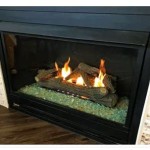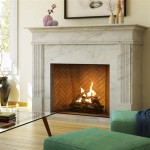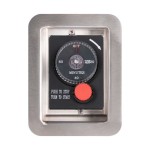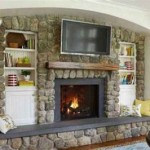Glass Tile Fireplace Designs: A Modern Hearth Transformation
Fireplaces have long been central design elements in homes, providing warmth, ambiance, and a focal point for gathering. As design preferences evolve, traditional materials like brick and stone are increasingly being complemented or replaced by contemporary alternatives. Glass tile, with its versatility, reflectivity, and wide array of colors and textures, has emerged as a popular choice for transforming fireplaces into stunning modern features.
The application of glass tile to a fireplace surround offers a transformative effect, adding a touch of sophistication and visual interest. The smooth, reflective surface of glass can brighten a room by bouncing light, while its ability to be manufactured in diverse shapes, sizes, and colors allows homeowners to achieve a truly customized look. Glass tile can be used to create minimalist designs, intricate mosaics, or bold, geometric patterns, catering to a wide range of architectural styles and personal tastes. Understanding the different types of glass tile and the factors that contribute to a successful installation are crucial for realizing a beautiful and durable glass tile fireplace.
Understanding the Variety of Glass Tile
Glass tile is not a monolithic material; it encompasses a wide range of types, each with its own unique properties and aesthetic qualities. Understanding these distinctions is essential for selecting the appropriate tile for a fireplace application.
Cast Glass Tile: This type of tile is made by pouring molten glass into molds and allowing it to cool. Cast glass tiles often have a three-dimensional texture or pattern, adding depth and visual interest to the fireplace surround. They are generally thicker and more durable than other types of glass tile, making them suitable for high-traffic areas or surfaces prone to impact. The inherent irregularities in the casting process can result in subtle variations in color and texture, lending a unique, handcrafted feel.
Fused Glass Tile: Fused glass tile is created by layering different pieces of glass and heating them together in a kiln until they fuse into a single piece. This process allows for the creation of complex patterns and color combinations. Fused glass tiles are often used for accent pieces or decorative borders due to their intricate designs and vibrant colors. They can be relatively expensive compared to other types of glass tile due to the labor-intensive manufacturing process.
Recycled Glass Tile: Made from recycled glass materials, this type of tile offers an environmentally friendly option for fireplace renovations. Recycled glass tile comes in a variety of colors and textures, often retaining subtle imperfections that add character and visual appeal. Choosing recycled glass tile contributes to sustainable building practices and reduces the environmental impact of construction projects.
Sheet Glass Tile: This is a common and relatively inexpensive type of glass tile. It's made by cutting large sheets of glass into smaller squares or rectangles. Typically back-painted to achieve the desired color, sheet glass tile offers a uniform appearance and is easy to clean. Sheet glass tile is available in a wide range of colors and sizes, making it a versatile option for various design schemes. However, it may lack the depth and texture of other types of glass tile.
Glass Mosaic Tile: These are small tiles, typically less than 2 inches in size, mounted on a mesh backing for easy installation. Glass mosaic tile offers endless design possibilities, allowing for the creation of intricate patterns, murals, and gradients. The large number of grout lines associated with mosaic tile provides added grip and slip resistance, making it a suitable option for areas where safety is a concern. Glass mosaic tiles are also often used to create decorative borders or accent features around a fireplace.
Key Considerations for Glass Tile Fireplace Installation
A successful glass tile fireplace installation requires careful planning and execution. Several factors need to be considered to ensure a durable, aesthetically pleasing, and safe result. These include substrate preparation, adhesive selection, grout application, and safety considerations.
Substrate Preparation: The substrate, or the surface to which the glass tile will be applied, must be clean, level, and structurally sound. Any existing paint, wallpaper, or other coatings should be removed, and the surface should be thoroughly cleaned to remove dust, grease, and other contaminants. Uneven surfaces should be leveled with a suitable patching compound. For fireplaces, it's crucial to use a backer board specifically designed for high-heat applications, such as cement board or a similar fire-resistant material. This will provide a stable and fire-resistant base for the glass tile.
Adhesive Selection: Choosing the right adhesive is critical for a long-lasting glass tile installation. A thin-set mortar specifically formulated for glass tile is recommended. These mortars are designed to adhere to the smooth surface of glass and to prevent the color of the mortar from affecting the appearance of the tile. Epoxy-based mortars can also be used, especially in areas exposed to moisture or high temperatures. It's essential to follow the manufacturer's instructions for mixing and applying the adhesive to ensure proper bonding.
Grout Application: Grout fills the spaces between the tiles, providing a watertight seal and a finished appearance. The choice of grout color can significantly impact the overall look of the fireplace. A light-colored grout will highlight the individual tiles, while a darker grout will create a more uniform appearance. Epoxy grout is a good option for glass tile fireplaces because it is stain-resistant, water-resistant, and durable. It doesn't require sealing, which simplifies maintenance. Regardless of the type of grout used, it's important to follow the manufacturer's instructions for mixing, applying, and cleaning. Excess grout should be removed promptly to prevent it from hardening on the surface of the tiles.
Safety Considerations: When installing glass tile around a fireplace, safety is paramount. Ensure that all materials used are fire-resistant and suitable for high-temperature applications. Maintain a safe distance between the glass tile and the fireplace opening to prevent overheating and potential damage. Consult local building codes and regulations to ensure that the fireplace installation meets all safety requirements. If you are not comfortable performing the installation yourself, it is best to hire a qualified professional.
Design Ideas and Inspiration
Glass tile opens up a world of design possibilities for fireplace surrounds. From minimalist designs to elaborate mosaics, the versatility of glass tile allows homeowners to create a fireplace that reflects their unique style and complements their home's décor.
Monochromatic Elegance: Using glass tile in a single color can create a sleek and sophisticated look. Choose a neutral color like white, gray, or beige for a timeless and versatile design. Varying the size and shape of the tiles can add subtle visual interest. For example, using large rectangular tiles for the main surround and smaller mosaic tiles for an accent border can create a balanced and harmonious design.
Bold Color Statements: For a more dramatic look, incorporate vibrant colors into the glass tile fireplace surround. Bold blues, greens, or reds can add a pop of color and create a focal point in the room. Consider using a combination of complementary colors to create a striking and eye-catching design. Be mindful of the overall color scheme of the room and choose colors that harmonize with the existing décor.
Geometric Patterns: Glass tile is ideal for creating geometric patterns on a fireplace surround. Herringbone, chevron, and stacked patterns can add visual interest and a modern touch. Experiment with different tile sizes and shapes to create unique and dynamic designs. Geometric patterns can be particularly effective in contemporary or minimalist interiors.
Mosaic Masterpieces: Glass mosaic tile allows for the creation of intricate and artistic fireplace surrounds. Consider commissioning a custom mosaic design featuring a landscape, floral pattern, or abstract artwork. Mosaic tiles can also be used to create decorative borders or accent features. The possibilities are endless when it comes to designing a unique and personalized mosaic fireplace surround.
Textured Glass Tile: Opting for textured glass tile adds depth and dimension to the fireplace surround. Cast glass tiles with raised patterns or fused glass tiles with etched designs can create a tactile and visually interesting surface. Textured glass tile is particularly effective in creating a rustic or natural look.
When selecting a glass tile design for a fireplace, consider the overall style of the home, the size of the room, and the desired level of visual impact. Experiment with different colors, textures, and patterns to create a fireplace that is both beautiful and functional.

Updated Fireplace Grey Amp Black Glass Tile Decor Home

Fireplace Tile Design Ideas For 2024 The

Modern White Marble Glass Kitchen Backsplash Tile Com Fireplace Surround Design

Fireplace Tile Design Westside And Stone

27 Cool Collection Glass Mosaic Fireplace Surround Home Decor And Garden Ideas Tile Around

Glass Tile Fireplace Watertown Stone

14 Fresh Designs For Tiled Fireplaces Bob Vila
These Tiled Fireplaces Are Swoon Worthy Tileist By Tilebar

Mosaic Tiled Fireplace Contemporary Living Room

Mosaic Tile Fireplace Design Inspiration Granite Transformations
Related Posts








